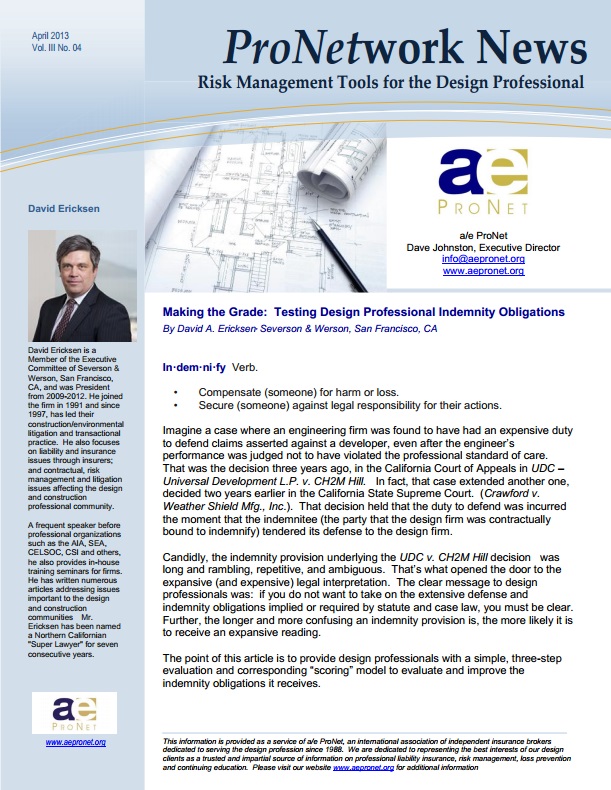• Compensate (someone) for harm or loss.
• Secure (someone) against legal responsibility for their actions.
Imagine a case where an engineering firm was found to have had an expensive duty to defend claims asserted against a developer, even after the engineer’s performance was judged not to have violated the professional standard of care. That was the decision three years ago, in the California Court of Appeals in UDC – Universal Development L.P. v. CH2M Hill. In fact, that case extended another one, decided two years earlier in the California State Supreme Court. (Crawford v. Weather Shield Mfg., Inc.). That decision held that the duty to defend was incurred the moment that the indemnitee (the party that the design firm was contractually bound to indemnify) tendered its defense to the design firm.
Candidly, the indemnity provision underlying the UDC v. CH2M Hill decision was long and rambling, repetitive, and ambiguous. That’s what opened the door to the expansive (and expensive) legal interpretation. The clear message to design professionals was: if you do not want to take on the extensive defense and indemnity obligations implied or required by statute and case law, you must be clear. Further, the longer and more confusing an indemnity provision is, the more likely it is to receive an expansive reading.
The point of this article is to provide design professionals with a simple, three-step evaluation and corresponding “scoring” model to evaluate and improve the indemnity obligations it receives.
The Warning Shot.
After reviewing hundreds of client-drafted indemnity provisions provided to architects and engineers, it seemed that well over half open with the phrase “to the maximum extent permitted by law” or its equivalent. These words would only come into play if the proposed indemnity clause were actually beyond what the law would allow. This clause is used to scale it back to what is legal and enforceable, as opposed to risking voiding the clause as a whole. This is not particularly common and may not even be effective in some situations.
What is far more telling, and potentially troubling, is the client attitude it conveys. Essentially, this language tells the design professional that the client seeks to transfer as much of its financial and legal risk as possible to the design professional. Ideally, it should be removed on the basis that the agreement (not the Courts or others) should define the rights and obligations between the parties. When a client will not do so, its reasons can be very telling.
Ten Words You Need To Use.
Many indemnity-related advisories and articles for design professionals focus on the negative. Too often, this fails to provide any guidance toward the positive solution. Just ten simple, aspirational words can move a clause from onerous to essentially fair, balanced, and largely insurable. Those “magic” words are:
“but solely to the extent actually caused by the negligent”
Those ten words result in five key accomplishments which dramatically balance and level the typical indemnity obligation.
This has been an excerpt of the April 2013 issue of ProNetwork News. Download the full PDF version of the newsletter here.
About the Author: David Ericksen is a Member of the Executive Committee of Severson & Werson, San Francisco, CA, and was President from 2009-2012. He joined the firm in 1991 and since 1997, has led their construction/environmental litigation and transactional practice. He also focuses on liability and insurance issues through insurers; and contractual, risk management and litigation issues affecting the design and construction professional community. A frequent speaker before professional organizations such as the AIA, SEA, CELSOC, CSI and others, he also provides in-house training seminars for firms. He has written numerous articles addressing issues important to the design and construction communities Mr. Ericksen has been named a Northern Californian “Super Lawyer” for seven consecutive years.




